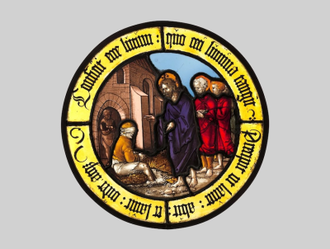Gospel in Art: Christ healing the blind beggar Bartimaeus

Roundel with Christ Healing the Blind Man, Hirschvogel Workshop, after Sebald Beham, Made in Nuremberg, Germany, 1517-27 © The Metropolitan Museum of Art, New York
Source: Christian Art
Gospel of 27 October 2024
Mark 10:46-52
As Jesus left Jericho with his disciples and a large crowd, Bartimaeus (that is, the son of Timaeus), a blind beggar, was sitting at the side of the road. When he heard that it was Jesus of Nazareth, he began to shout and to say, 'Son of David, Jesus, have pity on me.' And many of them scolded him and told him to keep quiet, but he only shouted all the louder, 'Son of David, have pity on me.' Jesus stopped and said, 'Call him here.' So they called the blind man. 'Courage,' they said 'get up; he is calling you.' So throwing off his cloak, he jumped up and went to Jesus. Then Jesus spoke, 'What do you want me to do for you?' 'Rabbuni,' the blind man said to him 'Master, let me see again.' Jesus said to him, 'Go; your faith has saved you.' And immediately his sight returned and he followed him along the road.
Reflection on the stained glass roundel
Bartimaeus, the central figure in today's Gospel reading, has always struck me as a person of remarkable spirit, despite the challenging circumstances of his life. His determination to make contact with Jesus is evident. He didn't quietly or politely approach the Lord; instead, he shouted out with boldness, "Son of David, Jesus, have pity on me." Even when the crowd scolded him and told him to be silent, Bartimaeus only raised his voice louder. Here was a man utterly focused on reaching Jesus, undeterred by those trying to put him in his place. It was his deep, desperate need that drove him to seek the Lord with such unwavering resolve.
And his determination bore fruit. Jesus took notice and, significantly, asked those very people who had tried to silence Bartimaeus to call him over. This first part of the story speaks volumes to us today. It encourages us to persist in seeking the Lord, even when we encounter resistance from those who might try to hold us back. Especially in a highly secularised society, most people would not want us to get close to Christ. In many ways, the culture around us often pressures us to remain silent about our faith. But we are called to embody the spirit of Bartimaeus-bold, determined, and relentless in our pursuit of God.
Our small stained glass roundel was made in Nuremberg between 1517-1527. One of the most significant developments in 16th century Nuremberg was the influence of the Italian Renaissance, which brought a more naturalistic style to stained glass designs. The glassmakers combined Gothic traditions with emerging Renaissance aesthetics, leading to more sophisticated shading techniques and three-dimensional effects. Artists like Veit Hirsvogel and the Hirschvogel family were notable figures in this period, contributing to the city's reputation for producing high-quality stained glass. These smaller roundels (only 30cm. in diameter) would have been made for private devotional worship. We see Bartimaeus depicted with exquisite detailing, sitting outside the walls of Jericho. A man is seen in the distance, stubborn, with arms crossed. He was probably one of the people who didn't want Bartimaeus to meet Jesus.
LINKS
Gospel in Art: https://christian.art/
Today's Reflection: https://christian.art/daily-gospel-reading/mark-10-46-52-2024-2/


















